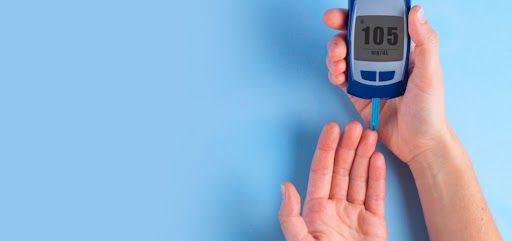Diabetes Management
All You Need To Know About Diabetes
18 min read
By Apollo 24|7, Published on - 05 October 2023, Updated on - 09 October 2023
Share this article
0
0 like

Diabetes mellitus, more commonly known as diabetes, is a chronic metabolic disease that affects millions worldwide. It leads to a high blood glucose level, either because your body has insufficient insulin production or is unable to use insulin.
If left undiagnosed, diabetes can lead to various complications such as cardiovascular disease, kidney failure, nerve damage, vision problems, and poor immunity. Individuals with diabetes can manage their condition through lifestyle modifications, timely medication, and regular monitoring of their blood glucose levels.
Here, we aim to provide comprehensive information on diabetes and its management. We will elaborate on the causes, symptoms, diagnosis, treatment options, and prevention strategies for both type 1 and type 2 diabetes.
Types of Diabetes
Some of the common types of diabetes include:
a. Prediabetes
This is a condition in which blood sugar levels are high levels but not adequately high to be considered diabetes (100 to 125 mg/dL). It can be considered a warning sign for type 2 diabetes. Research shows there is a 14% estimated prevalence of prediabetes in India.
b. Type 1 Diabetes
This type of diabetes occurs when the body's immune system mistakenly attacks and destroys the insulin-producing beta cells in the pancreas. It typically occurs in children and young adults and is commonly known as juvenile diabetes.
c. Type 2 Diabetes
Type 2 diabetes is the most common form of diabetes and makes up 90% of all diabetes cases. It occurs when the body becomes resistant to insulin or does not produce enough insulin to maintain normal blood sugar levels. Risk factors for type 2 diabetes include obesity, physical inactivity, unhealthy diet, and family history.
d. Gestational Diabetes
This type of diabetes occurs during pregnancy and usually resolves after delivery. In 2021,16.7% of women who gave birth were reported to be affected by gestational diabetes. Women who have had gestational diabetes are at a higher risk of developing type 2 diabetes later in life.
e. Diabetes Insipidus
Unlike the other types of diabetes that involve problems with insulin production or utilization, diabetes insipidus is a rare condition that affects the kidneys' ability to conserve water. It can lead to excessive thirst and urination. In contrast to the other types, this type of diabetes is not related to blood sugar control.
To understand how the body moves to a diabetic state and fails to metabolise sugar appropriately, one should understand the causes underlying diabetes.
Causes and Risk Factors of Diabetes
There's no simple approach to finding out what causes diabetes and what are the risk factors of diabetes. It is a complex condition and can have a plethora of contributing factors, including genetic and environmental factors.
Here are some of the most common causes of diabetes mellitus and other types of diabetes:
a. Heredity/Family History
Genetics play a significant role in the development of diabetes. If you have a close family member, such as a parent or sibling, with diabetes, your risk of developing the condition increases. Studies have shown that a person with a family history of diabetes has a 20% to 80% chance of developing the disease.
b. Insulin Resistance
Insulin resistance occurs when the body's cells do not respond properly to insulin, resulting in elevated blood sugar levels. This is a common feature of type 2 diabetes and is often associated with obesity and a sedentary lifestyle.
c. Obesity
Excess weight, particularly around the waistline, is a major risk factor for developing type 2 diabetes. A high body mass index (BMI) significantly increases the chances of insulin resistance and impaired glucose metabolism.
d. Genetic Disorders
Certain genetic disorders, such as Down syndrome, are associated with an increased risk of developing diabetes. These conditions affect the functioning of various organs and systems in the body, including the pancreas.
e. Hormonal Disorders
Hormonal imbalances, such as polycystic ovary syndrome (PCOS) and Cushing's syndrome, may contribute to the development of insulin resistance and type 2 diabetes.
f. Pancreas Disorder or Damage
The pancreas plays a crucial role in regulating blood sugar levels by producing insulin. Any damage or dysfunction of this organ can impair insulin production and lead to an increased risk of diabetes.
g. Unhealthy Eating Habits
A diet high in processed foods, sugary beverages, and unhealthy fats can contribute to weight gain and insulin resistance. Both of these factors are considered risk factors for diabetes. Refined sugars are easily digested by the body and can cause sudden spikes in glucose levels, which are detrimental to metabolic health. Also, eating high-sugar foods for an extended period makes the body resistant to leptin, a hormone that modulates the body's hunger signals.
h. Physical Inactivity
Leading a sedentary lifestyle is strongly associated with an increased risk of diabetes. Physical inactivity coupled with poor eating habits can lead to obesity. Both physical inactivity and obesity are risk factors for type 2 diabetes.
Fat tissues periodically release free fatty acids (molecules that are the building blocks of fat). These fatty acids can move across the body and reduce insulin sensitivity in tissues and muscles, owing to which cells are no longer able to use glucose. This raises the blood sugar level and may lead to type 2 diabetes if the condition exists for long.
i. Medications
Some medications, such as corticosteroids, antipsychotics, and some HIV medications, have been linked to an increased risk of diabetes.
Corticosteroids and antipsychotics reduce the sensitivity of liver tissues to insulin molecules. Thus, the liver keeps releasing glucose molecules into the blood, even when the blood insulin levels are high, leading to high blood glucose levels. These drugs can also cause other cells to become insulin-resistant, thus reducing glucose uptake in these cells and increasing blood sugar levels.
Signs and Symptoms of Diabetes
Knowing the early signs of type 1 and type 2 diabetes can help avert possible health complications. Here are some key indicators that may suggest you have diabetes:
- Frequent Urination: Experiencing an increased need to urinate, especially during the night, could be a sign of diabetes. This occurs because high levels of glucose in the blood can hinder the kidneys' ability to filter it, leading to increased urine production.
- b. Persistent Hunger and Thirst: Diabetes affects the body's ability to regulate blood sugar levels. When blood sugar is consistently high, it leads to excessive urination, which may lead to high levels of fluid loss. The body tries to compensate for this loss by inducing thirst.
- Unexplained Weight Loss: Losing weight without a definite cause can be a symptom of diabetes. In type 1 diabetes, the body does not produce enough insulin, leading to the uncontrolled breakdown of fat and muscle tissue for energy.
- Fatigue and Tiredness: Feeling excessively tired or fatigued, even after adequate rest, can be a symptom of diabetes. When glucose cannot enter the cells effectively due to insulin resistance or lack of insulin production, the body's energy supply is compromised, resulting in fatigue.
- Slow Healing of Wounds: High blood sugar levels can lead to the stiffening of arteries and veins, disrupting blood circulation. This can be detrimental to wound healing because it delays the oxygenation of wounded tissues and also disrupts the movement of leukocytes (immune cells that help in cell repair) to the wound. This can impair the body's ability to heal wounds. If you notice that cuts or sores are taking longer than usual to heal or are prone to infection, it could be a sign of diabetes.
- Tingling Sensation or Numbness in Hands and Feet: Elevated blood sugar levels can cause nerve damage over time, leading to tingling sensations or numbness in the extremities. This condition is known as diabetic neuropathy.
- Blurred Vision: Diabetes can affect the blood vessels in the eyes, leading to blurry vision. If left uncontrolled, it can cause long-term vision problems or even blindness.
These diabetes symptoms may vary between individuals, and some people may not experience any symptoms at all, especially in the early stages of diabetes. Therefore, regular check-ups and screenings are essential for prevention or early detection of diabetes.
Diagnosis and Screening of Diabetes
Diagnosing and screening for diabetes is crucial to identify the condition early and initiate appropriate treatment. There are several tests available that healthcare professionals can use to diagnose and screen for diabetes. These tests include blood tests and urine tests.
Blood tests are the primary method used to diagnose and screen for diabetes. The following blood tests are commonly used:
- HbA1C (glycated haemoglobin): When excess glucose molecules are present in the blood, they form a complex with haemoglobin molecules. A high HbA1C level can indicate persistently high blood sugar levels during the preceding 2 to 3 months, which points to diabetes. An HbA1C level of 6.5% or higher is indicative of diabetes.
- Glucose fasting: This test measures blood sugar levels after an overnight fast. A fasting blood glucose level of 126 mg/dL or higher on two separate occasions can be indicative of diabetes.
- Glucose PP (postprandial): This test measures blood sugar levels two hours after a regular meal. A glucose PP level of 200 mg/dL or higher on two separate occasions is indicative of diabetes.
- Glucose random: This test measures blood sugar levels at any time of the day, regardless of when the person last ate. A random glucose level of 200 mg/dL or higher, accompanied by symptoms of diabetes, indicates diabetes.
- Oral Glucose Tolerance Test (OGTT): This test involves drinking a sugary solution and measuring blood sugar levels before and two hours after consuming the solution. A blood sugar level of 200 mg/dL or higher two hours after the glucose drink indicates diabetes.
Urine tests, such as urinalysis, can also be used to detect diabetes. While urine tests are not used to diagnose diabetes, they can help detect high blood sugar levels. If a urine sample contains excessive glucose, it may indicate uncontrolled diabetes.
Stages of Diabetes
Understanding the stages of diabetes is crucial for early detection, effective management, and prevention of complications. There are different stages for both type 1 and type 2 diabetes, each with its unique characteristics and progression.
Stages of Type 1 Diabetes
1. Stage 1: Presence of two or more autoantibodies: This initial stage is marked by the presence of two or more autoantibodies related to diabetes. This indicates that the body's immune system is attacking the insulin-producing beta cells in the pancreas.
2. Stage 2: Presence of two or more autoantibodies and abnormally high glucose levels: In this stage, two or more autoantibodies are detected, and the patient has persistently high blood glucose.
3. Stage 3: Diagnosis: This stage involves the official diagnosis based on clinical diabetes mellitus symptoms, blood glucose levels, and other diagnostic criteria. It is essential to diagnose type 1 diabetes promptly to initiate appropriate treatment and prevent complications.
Stages of Type 2 Diabetes
1. Stage 1: Insulin resistance: Type 2 diabetes typically begins with insulin resistance, where the body's cells and insulin receptors become less responsive to the action of insulin. Over time, this leads to elevated blood glucose levels as the body struggles to maintain normal glucose metabolism.
2. Stage 2: Prediabetes: Prediabetes is a precursor to type 2 diabetes. Individuals with prediabetes have higher than normal blood glucose levels but are not high enough to be diagnosed with diabetes. The blood glucose value ranges from 110 to 125 mg/dL.
3. Stage 3: Diagnosis: In this stage, a person meets the diagnostic criteria for type 2 diabetes, which includes elevated blood glucose levels during fasting or after a glucose challenge test.
4. Stage 4: Complications: If left unmanaged, type 2 diabetes can lead to various complications affecting the heart, kidneys, eyes, nerves, and other vital organs. According to the WHO, approximately 2 million deaths worldwide were attributed to diabetes and diabetes-related kidney problems in 2019.
Complications of Diabetes
Persistently high levels of blood sugar can lead to inflammation and other detrimental effects on the body. These can in turn affect organ health and function, reducing the quality of life of diabetics.
Here are some of the most common complications of diabetes mellitus:
1. Neuropathy
- Diabetes can cause damage to the nerves in the body, resulting in neuropathy (i.e., dysfunction of neurons).
- Symptoms may include numbness, tingling, and pain in the extremities, as well as problems with digestion, urinary function, and sexual function.
- The prevalence of peripheral diabetic neuropathy can range from 9.6% to 78% in India.
2. Nephropathy
- Diabetic nephropathy is a kidney disorder reported in individuals with diabetes.
- High levels of blood sugar can damage the blood vessels in the kidneys, leading to impaired kidney function. Moreover, high blood sugar levels can overwhelm the kidneys and weaken their ability to filter waste.
- It iis estimated that 20-30% of people with diabetes will likely develop nephropathy.
3. Retinopathy
- Diabetes can cause damage to the blood vessels in the retina, leading to retinopathy.
- Symptoms may include blurry vision, vision loss, floaters, and even blindness if left untreated.
4. Cardiovascular Diseases
- Diabetes may result in high blood pressure, high cholesterol levels, and narrowing of blood vessels, thereby increasing the risk of developing cardiovascular diseases such as heart attacks.
- Lifestyle modifications including a healthy diet, regular exercise, and medication management can greatly reduce the risk of cardiovascular diseases in people with diabetes.
5. Diabetic Foot
- Diabetes can cause nerve damage and reduced blood flow to the feet, resulting in foot problems.
- Nerve damage can lead to loss of sensation, making it difficult to detect injuries or infections.
- Poor blood flow can slow down the healing process and increase the risk of infections and ulcers.
- Research says up to 19% to 34% of people with diabetes are likely to develop diabetic foot ulcers.
Treatment Options for Diabetes
Currently, there are no established methods for curing diabetes. That said, reversing diabetes may be possible in some cases. "Reversing diabetes" refers to restoring optimal blood glucose levels and attenuating the negative effects of diabetes, such as neuropathy and cardiovascular disease risk.
There are multiple approaches to controlling diabetes, including treatment with and without medications. Let's learn more:
1. Medications
Medications play a crucial role in diabetes treatment by helping the regulation of blood sugar levels. Some of the common medications used for diabetics include:
- Metformin: This is often the first-line type 2 diabetes treatment. Metformin works by decreasing glucose production in the liver and improving insulin sensitivity.
- Sulfonylureas: These medications stimulate the pancreas to release more insulin, thus lowering blood sugar levels.
- DPP-4 inhibitors: These medications help to lower blood sugar by blocking the action of an enzyme that breaks down incretin hormones, which are responsible for stimulating insulin release.
2. Insulin shots
Insulin shots can be essential for treating diabetes, especially type 1. Insulin is a hormone that helps regulate blood sugar levels by allowing glucose to enter cells for energy production. When the hormone is not produced adequately in the body (due to damage to insulin-producing beta cells), it must be administered externally.
There are different types of insulin, including rapid-acting, short-acting, intermediate-acting, and long-acting. The choice of insulin depends on individual needs and lifestyle and is recommended by the doctor.
3. Dietary Changes
Dietary changes are a fundamental part of managing diabetes. A healthy eating plan can help control blood sugar levels and reduce the risk of complications. Key dietary recommendations for diabetes management include:
- Monitoring carbohydrate intake: While carbohydrates are unavoidable, people with diabetes should monitor their intake of simple carbohydrates like rice or sugar, and switch to complex carbohydrates like brown rice and oats. The latter takes more time to digest and thus prevents spikes in glucose levels.
- Choosing healthy fats: Opting for sources of unsaturated fats, such as peanuts and olive oil, can help improve heart health and manage blood sugar levels.
- Emphasizing whole foods: Including plenty of fruits, vegetables, whole grains, lean proteins, and low-fat dairy products can provide essential nutrients and keep blood sugar levels stable. Whole foods usually contain complex nutrients and a higher fibre content, because of which they take more time to digest. This can help establish metabolic stability and prevent sudden spikes in glucose levels ?
4. Lifestyle Changes
Lifestyle changes are crucial in managing diabetes effectively. These may include:
- Regular physical activity: Engaging in regular exercise helps improve insulin sensitivity and can lower blood sugar levels. Aim for at least 150 minutes of moderate-intensity aerobic activity each week, along with strength training exercises.
- Weight management: Achieving and maintaining a healthy weight can significantly improve diabetes control and reduce the risk of complications.
- Stress management: High levels of stress can increase the levels of the stress hormone cortisol, which can affect blood sugar levels adversely. Finding healthy ways to manage stress, such as through exercise or meditation, can be beneficial.
Preventing Diabetes
When a person is at a high risk of diabetes due to heredity or lifestyle choices, they should take some steps early on to avoid diabetes.
Here's what one can do to prevent diabetes:
1. Manage Obesity
Obesity is a major risk factor for developing type 2 diabetes. Maintaining a healthy weight is crucial in preventing this condition. Losing just 5-7% of body weight can significantly reduce the risk of developing diabetes.
2. Maintain a Healthy Diet
A healthy diet plays a crucial role in preventing diabetes. Here are some tips on the same:
- If a person has diabetes, they should opt for foods that are low in saturated fats, trans fats, cholesterol, and sodium.
- Adding fruits, vegetables, whole grains, lean proteins, and healthy fats like nuts to the diet can help maintain a stable metabolism and prevent glucose spikes.
- Sugary beverages, processed snacks, and foods high in refined carbohydrates should be avoided in a diabetic diet chart to ensure balanced metabolism. These food items are digested easily and can cause glucose spikes.
3. Get Regular Exercise and Physical Activity
Engaging in regular exercise and physical activity not only helps with weight management but also improves insulin sensitivity and blood sugar control. Starting with activities that you enjoy, such as walking, swimming, dancing, or cycling, can help build interest in your workout routine. Incorporating strength training exercises at least two days a week can help build muscle mass and improve overall metabolic health.
4. Avoid Smoking and Excessive Alcohol Consumption
Smoking is strongly associated with a high risk of developing diabetes. Excessive alcohol consumption can lead to weight gain and increase the risk of developing diabetes. Limit your alcohol intake to moderate levels and consider quitting smoking to reduce your risk of diabetes.
By following these preventive measures, you can significantly lower your risk of developing diabetes. Remember to consult with a healthcare professional for personalized advice and guidance.
Living with Diabetes
Living with diabetes can have a profound emotional impact on individuals. It is a chronic condition and may require dietary restrictions and multiple lifestyle changes for recovery. Individuals may feel overwhelmed by the sudden shift in their life as they know it.
Studies have shown that the prevalence of depression is high in patients with diabetes. In fact, diabetes and depression tend to exhibit a bidirectional relationship, as depression may also lead to the onset of diabetes symptoms.
It is essential to acknowledge and address these mental health conditions to ensure overall well-being. To begin with, individuals should consider joining support groups to share their experiences and deal better with their emotions.
Here are some key points to consider:
a. Coping with the Emotional Impact
Diabetes can be overwhelming, leading to feelings of frustration, anger, or even sadness. It is crucial to recognize and validate these emotions. Seek support from loved ones or professional counsellors who can provide a safe space to express your feelings and concerns.
b. Support Groups and Resources
Support groups can be an invaluable resource for individuals living with diabetes. They provide a sense of community and a platform for sharing experiences, knowledge, and advice regarding the management of this condition. Join local or online support groups where you can connect with others facing similar challenges.
You can also use online resources such as reputable websites, forums, or social media groups dedicated to diabetes management.
c. Managing Lifestyle Changes
Managing diabetes often requires implementing significant lifestyle changes. Here are some key tips to implement lifestyle changes successfully:
- To adopt a well-balanced diet, ensure that you have sufficient protein (pulses, eggs, meat, or fish) and fibre (salads, vegetables, and fruits) with each meal. Experts say that a colourful plate of food is usually well-balanced.
- Regular physical activity is crucial for managing blood glucose levels. To begin with, you can go for short walks or exercise for 10 minutes at a stretch.
- Once you feel like you are ready to advance, increase your exercise duration by 5 minutes each week. If you cannot find time, try to exercise for 15 minutes, twice a day. The optimal duration is 150 minutes of moderate-intensity exercise per week.
- Monitoring your blood glucose levels regularly is essential if you have diabetes. You can keep an electronic glucometer handy for this. These devices are portable and easily available. You can set a reminder for yourself to check your blood glucose at periodic intervals (every day or every 2 to 3 days).
- For a more comprehensive health check, opt for a blood test that shows your HbA1C levels at least once every 2 to 3 months.
- Maintain a healthy body weight, as excess weight can increase insulin resistance. You can keep a weighing scale handy, and you can weigh yourself every 1 to 2 weeks. This is especially important if you try out a new exercise routine or change your diet.
d. Communicating with Healthcare Providers
Open and effective communication with healthcare providers is essential for successful diabetes management. Consider the following tips:
- Prepare for healthcare appointments by making a list of questions or concerns beforehand.
- Be honest and transparent about your lifestyle habits and challenges faced in managing diabetes.
- Ask for clarification if you do not understand something your healthcare provider has said.
- Participate actively in decision-making with your healthcare provider to ensure that your treatment plan aligns with your goals and preferences.
In conclusion, living with diabetes can be challenging, but with the right strategies, support, and resources, individuals can effectively manage their condition and lead fulfilling lives. It is crucial to address the emotional impact, seek support from support groups and resources, manage lifestyle changes, and maintain open communication with healthcare providers. Remember, you are not alone in this journey, and by taking proactive steps, you can navigate the challenges of diabetes successfully.
Diabetes Management
Consult Top Diabetologists
View AllLeave Comment
Recommended for you

Diabetes Management
The Connection Between Diabetes and Polycystic Ovary Syndrome
Did you know there's a significant link between diabetes and polycystic ovary syndrome (PCOS)? From insulin resistance being a contributing factor, even women with normal body mass index and PCOS are at an increased risk of Type 2 diabetes. Understanding this link can pave the way for effective diagnosis and management of both conditions. Regular monitoring of blood sugar, following a balanced diet, incorporating regular physical activity, and taking prescribed medications can help.
.jpg?tr=q-80)
Diabetes Management
Balancing Diabetes & Exercise: Techniques, Timing and Why It Matters
By exercising regularly, you are taking a proactive step toward self-managing your diabetes effectively. You can achieve better blood glucose control, improve your insulin sensitivity, and maintain a healthy weight by choosing a combination of aerobic, resistance, and flexibility exercises and timing them appropriately. Remember, every step counts in your fight against diabetes.

Diabetes Management
Why good sleep is necessary to keep lifestyle diseases at bay
Good sleep plays a crucial role in preventing lifestyle diseases. Lack of sleep disrupts the hormonal balance that regulates appetite and energy metabolism, leading to increased calorie consumption and weight gain. Inadequate sleep can impair glucose metabolism and insulin regulation, increasing the risk of type 2 diabetes.
Subscribe
Sign up for our free Health Library Daily Newsletter
Get doctor-approved health tips, news, and more.
Visual Stories

8 Fruits That are Incredibly Healthy for Diabetes
Tap to continue exploring
Recommended for you

Diabetes Management
The Connection Between Diabetes and Polycystic Ovary Syndrome
Did you know there's a significant link between diabetes and polycystic ovary syndrome (PCOS)? From insulin resistance being a contributing factor, even women with normal body mass index and PCOS are at an increased risk of Type 2 diabetes. Understanding this link can pave the way for effective diagnosis and management of both conditions. Regular monitoring of blood sugar, following a balanced diet, incorporating regular physical activity, and taking prescribed medications can help.
.jpg?tr=q-80)
Diabetes Management
Balancing Diabetes & Exercise: Techniques, Timing and Why It Matters
By exercising regularly, you are taking a proactive step toward self-managing your diabetes effectively. You can achieve better blood glucose control, improve your insulin sensitivity, and maintain a healthy weight by choosing a combination of aerobic, resistance, and flexibility exercises and timing them appropriately. Remember, every step counts in your fight against diabetes.

Diabetes Management
Why good sleep is necessary to keep lifestyle diseases at bay
Good sleep plays a crucial role in preventing lifestyle diseases. Lack of sleep disrupts the hormonal balance that regulates appetite and energy metabolism, leading to increased calorie consumption and weight gain. Inadequate sleep can impair glucose metabolism and insulin regulation, increasing the risk of type 2 diabetes.

